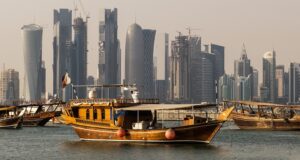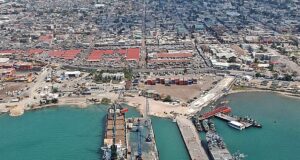August 3rd, 2016
By Davis Florick – Junior Fellow
On July 12th the Permanent Court of Arbitration in The Hague released its ruling on China’s expansive historical claims in the South China Sea. In 2013, Manila had brought the case against Beijing in response to China claiming the Scarborough Shoal and denying the use of the surrounding waters to the Philippines. The decision this month reinforced the position that the only mechanism to assert territorial control at sea is the United Nations Convention on the Law of the Sea (UNCLOS). Before the Court’s decision had even been issued, however, China consistently indicated it would not recognize the verdict regardless of the outcome. In light of regional stratification, the judgment, and China’s response, it is important to look back at who has used the South China Sea and in what manner. Understanding the role different communities have played in shaping regional affairs places current problems in better context.
The Permanent Court of Arbitration’s ruling addresses three elements of the confrontation in the South China Sea, each of which will have a significant impact on regional politics. Collectively, the Court’s ruling is a sweeping rejection of China’s claims. The three statements include determinations that:
- There is no legal basis for China’s historical territorial claims – only claims consistent with UNCLOS are valid;
- None of the Spratly Islands constitute islands under UNCLOS; and
- China has jeopardized fragile ecosystems through unlawful fishing and has gone a step further by protecting its fishing vessels with government support.
Taken as a whole, these three points erode much of Beijing’s claims in the region. The primary thrust of the Permanent Court’s position is that UNCLOS, which China ratified in 1996, creates Exclusive Economic Zones extending 200 nautical miles from mainland territory and islands. Because the territory China claims does not for the most part constitute islands, Beijing’s defeat was predictable. However, with few expecting China to abide by the ruling, there is prudence in considering the historical role the South China Sea has played.
From the earliest times, the South China Sea has been a major source of sustenance for the diverse peoples in the region. The warm waters have attracted extensive quantities of marine life that have supported the diets of people throughout Southeast Asia. There are many theories regarding how humans came to live on the surrounding lands; however, Professor Bill Solheim had developed an interesting theory – since supported by archeological findings – on how cultural norms and goods moved across the region. Thousands of years ago, there was a group of people, referred to as the “Nusantao,” that survived on the seas. These individuals would not have considered themselves to be a nation-state in the present sense. While they would use land as a means for weather protection and trade, they largely functioned on the high seas and fresh water bodies such as the Mekong River. These people helped expedite trade and brought culture from one part of the region to elsewhere. They are likely the first people to have discovered the islands in the South China Sea; yet, the notion of claiming territory at sea does not appear to have been a consideration for them. Evidence for the existence of such people is supported by what are commonly referred to as “boat people” still in existence. The Tanka in southern China, the Dan in Vietnam, and the Bajau in Malaysia could all be classified as modern versions of the Nusantao. From these people emerges the most likely theory for how early interaction in the South China Sea took place.
Gradually, trading centers emerged across the region. Chinese records from approximately two thousand years ago indicate that a state they referred to as “Funan,” existing in southern Vietnam, was the prominent trading center. There were others at the time, particularly in Indonesia and Malaysia, but the geographical fortuity of Funan separated it from regional competitors. Archaeologists have found evidence suggesting it was around this time that trade between and among Europe, the Middle East, South Asia, and East Asia began. While the Nusantao likely initiated these trade links, Persian, Indian, Chinese, and Southeast Asian traders accelerated the process. Because the climates in the South China Sea and Indian Ocean limited conducive sailing opportunities to the winter and summer, there were periods of approximately four months where merchants would reside in Southeast Asian cities, because they were unable to return home. This provided chances for cultural exchange and helps explain the existence of Chinese and Indian influences in the region.
The reliance on both Chinese and Indian rulers to maintain the vibrant trading centers meant that local leaders had to ensure the cooperation of their larger partners. What emerged was a vassal-like relationship where tribute was paid by regional actors to Chinese and Indian entities. In the case of China, the Han Dynasty, 206 BCE – 220 CE, compounded the complexity by invading northern Vietnam, thereby creating a more dynamic tribute series. Yet, Chinese governance never extended to the southern reaches of the South China Sea. Today, some in China have asserted the tributary system as proof-positive they had influence over the South China Sea. As could be predicted, Southeast Asian experts have countered that paying Chinese leaders was a way to ensure market access – similar to what occurred with India. What complicates matters today is that the rich history of written record keeping and preservation in China has provided its scholars with added strength. This lies in stark comparison to the relatively sparse records surviving today in Southeast Asia. Regardless, even when Funan faded in the fourth century, Champa in modern day Vietnam, Srivijaya in Indonesia, and others emerged.
Although the Tang Dynasty (618 CE – 907) encouraged trade with state control, it was the Song Dynasty (960 CE – 1279) that freed Chinese merchants to explore markets abroad. Under the Song’s leadership, Chinese communities rapidly emerged across Southeast Asia. The roots that were laid down during this period considerably advance the logic behind current Chinese trading communities in the modern states but, more importantly, explain the continued primacy of Chinese involvement in South China Sea trade even when policies of the Yuan, Ming, and Qing Dynasties promoted isolationism.
Throughout most of the tenth through the fifteenth centuries, control of the features in the South China Sea was not a high priority. Toward the end of the era, however, Chinese long distance naval exploration did become important. Some have suggested that Chinese naval activity hit a high water mark in the fifteenth centuries with the voyages of Zheng He and others between 1403 and ~1433. While Chinese officials have sought to portray these undertakings as goodwill expeditions, there are also findings that suggest Zheng was involved in conflicts in Sumatra, Java, Malay, Sri Lanka, and even the Arabian Peninsula. Notwithstanding, the first European arrivals in the sixteenth century would set the Asia-Pacific region on a radically different course.
Culminating in the thorough colonization of Southeast Asia in the nineteenth century and claiming of territory in the South China Sea in the early twentieth century, Europeans changed the way indigenous peoples viewed the seas. Beginning with Vasco da Gama’s maritime expedition to India in 1498, Europeans pushed eastward toward Asia. For three hundred years, the relationship centered on trade with limited territorial conquest. The Opium Wars in China (1839-1842 and 1856-1860), as well as France’s conquest of Vietnam, changed regional dynamics.
In the waning days of the Qing Dynasty (1907), the government sought to rally behind national pride by identifying Pratas Island and the Paracel Islands as Chinese territory. In 1914, the Chinese cartographer Hu Jinjie asserted China’s line of control as extending to the 15th parallel, thereby including Pratas Island and the Paracel Islands, while excluding the Spratly’s. As one might expect, during the warlord period and early 1930’s, which included the early Chiang Kai-shek reign, Hu’s maps were the standard. It was not until April 1933 when France annexed Spratly Island and five others that Chinese interest was piqued. By then in the throes of civil war, Chiang Kai-shek’s government was powerless to intervene and push back against France. Interestingly, the Japanese were the first to complain – they claimed the mining company, Rasa Industries, had been pursuing guano on marine features – yet their arguments were ignored. For the Chinese part, without the naval assets to respond, they again returned to map making. Until 1936, various lists and maps were produced that began to awkwardly grope for both the Paracel and Spratly Islands. Not until 1936 when Bai Meichu created the New China Construction Atlas did the U-shaped line we now know as China’s historic claims come to fruition. Of course, World War Two would fundamentally alter the political landscape in Asia.
For most of the South China Sea’s history, its waters have enjoyed a rich tradition of cross-cultural communication. The shared cultures and goods created one of the most vibrant communities of antiquity. Indeed, its waterways have been pivotal in bridging the east-west divide. Although tensions have grown in recent decades – even more so in the last few years – the South China Sea continues to play a vital role in moving goods around the world. While the Philippines-China Permanent Court of Arbitration ruling reaffirms the primacy of UNCLOS, thereby rejecting Beijing’s historical claims, the sea’s background is important. The community and markets the South China Sea has invigorated for millennia can continue to benefit all should the governments in the region allow it.
Title image by DigitalGlobe, via CSIS Asia Maritime Transparency Initiative.
 Human Security Centre Human Rights and International Security Research
Human Security Centre Human Rights and International Security Research



